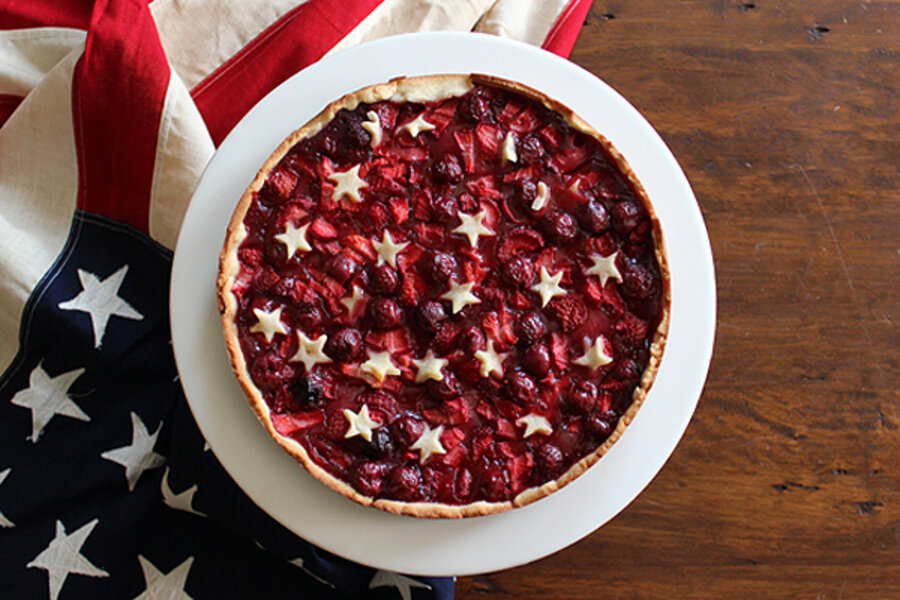By Caroline Lubbers, Whipped, The Blog
Filling recipe from Food Network
Makes one 10-inch tart
1-1/2 cups fresh or frozen tart cherries
1/2 cup granulated sugar
2 tablespoons cornstarch
1/8 tablespoon almond extract (optional)
1 cup chopped, fresh strawberries
1 tart crust (see recipe below)
For the filling:
1. Place cherries in medium saucepan and place over heat. Cover. After the cherries lose considerable juice, which may take a few minutes, remove from heat. In a small bowl, mix the sugar and cornstarch together. Pour this mixture into the hot cherries and mix well. Add the almond extract, if desired, and mix. Return the mixture to the stove and cook over low heat until thickened, stirring frequently. Remove from the heat and let cool. Stir in the strawberries.
2. Preheat the oven to 375 degrees F.
3. Use your favorite tart dough recipe or the one below. Prepare your crust. Roll it out large enough to fit into your tart pan. Use scraps to make stars if you wish. Pour cooled cherry mixture into the crust. Dot the top with crust stars.
4. Bake for about about 40 minutes or until the crust is golden and the center is bubbling. Remove from the oven and place on a rack to cool.
For the Sweet Tart Dough
From "Chocolate Desserts" by Pierre Hermé, written by Dorie Greenspan
Make this at least 1 day in advance because you need to chill and rest the dough for a minimum 4 hours or up to 2 days, before rolling and baking
2-1/2 sticks (10 ounces; 285 grams) unsalted butter, at room temperature
1-1/2 cups (150 grams) icing sugar, sifted
1/2 cup (lightly packed) (3-1/4 ounces; 100 grams) finely ground almond powder
1/2 teaspoon salt
1/2 teaspoon vanilla bean pulp or pure vanilla extract
2 large eggs, at room temperature, lightly beaten
3-1/2 cups (490 grams) all-purpose flour
To make the dough in a mixer:
1. Place the butter in the bowl of a mixer fitted with the paddle attachment and beat on low speed until creamy. Add the sugar, almond powder, salt, vanilla and eggs and, still working on low speed, beat to blend the ingredients, scraping down the paddle and the sides of the bowl as needed. The dough may look curdled – that’s alright. With the machine on low, add the flour in three or four additions and mix only until the mixture comes together to form a soft, moist dough – a matter of seconds. Don’t overdo it.
2. Gather the dough into a ball and divide it into 3 or 4 pieces: 3 pieces for 10-inch (26cm) tarts, 4 for 9-inch (24cm) tarts. Gently press each piece into a disk and wrap each disk in plastic. Allow the dough to rest in the refrigerator for at least 4 hours, or for up to 2 days, before rolling and baking. (The dough can be wrapped airtight and frozen for up to a month.)
To roll and bake:
1. For each tart, place a buttered tart ring on a parchment-lined baking sheet and keep close at hand. Work with one piece of dough at a time; keep the remaining dough in the refrigerator.
2. Working on a lightly floured surface (marble is ideal), roll the dough to a thickness of between 1/16 and 1/8 inch (2 and 4 mm), lifting the dough often and making certain that the work surface and dough are amply floured at all times.
Roll the dough up around your rolling pin and unroll it onto the tart ring. Fit the dough into the bottom and up the sides of the ring, then run your rolling pin across the top of the ring to cut off the excess. If the dough cracks or splits as you work, don’t worry – patch the cracks with scraps (moisten the edges with water to “glue” them in place) and just make certain not to stretch the dough that’s in the pan.
(If you plan to use the crusts baked and filled with fresh fruit or cream, continue with the next steps)
Prick the dough all over with the tines of a fork and chill it for at least 30 minutes in the refrigerator.
3. When you are ready to bake the crust(s), preheat the oven to 350 degrees F (180 degrees C). Fit a circle of parchment or foil into the crust and fill with dried beans or rice.
4. Bake the crust for 18 to 20 minutes, just until it is very lightly colored. If the crust needs to be fully baked, remove the parchment and beans and bake the crust for another 3 to 5 minutes, or until golden. Transfer the crust to a rack to cool.
Keeping: The dough can be kept in the refrigerator for up to 2 days or wrapped airtight and frozen for a month. Frozen disks of dough take about 45 minutes to an hour at average room temperature to reach a good rolling-out consistency. Baked crusts can be kept uncovered at room temperature for about 8 hours.







